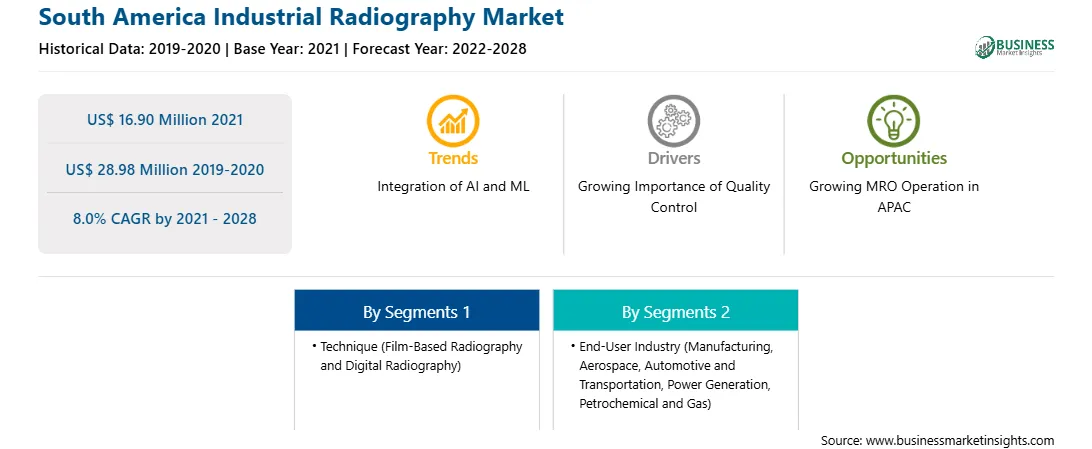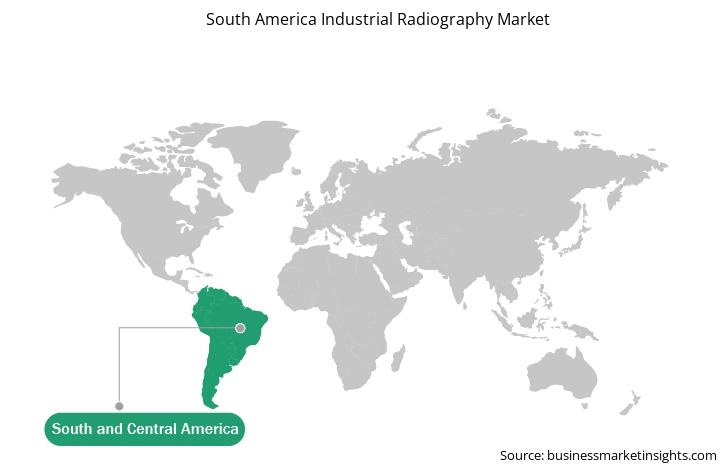The industrial radiography market in SAM is segmented into Brazil, Argentina, and the Rest of SAM. The Rest of SAM comprises Chile, Colombia, Guatemala, and Peru. Several initiatives are taken by governments to support the growth of the technology sector. For instance, Argentina is concentrating on attracting FDIs by taking several initiatives, such as easing import restrictions, signing international bilateral agreements, and removing restrictions on foreign investment. Such initiatives help SAM countries develop their industrial sector. Moreover, the growing middle-class population in the region is positively affecting the growth of the aviation industry. Further, the demand for aircraft in this region is expected to increase in the future owing to the development of the airport infrastructure, improvement in the air transportation network, and the high share of low-cost transportation in domestic routes along with the active operation of large aviation holding companies and national airlines. Thus, with the growing MRO operations in this region, the adoption of industrial radiography is expected to increase in the coming years. Moreover, in 2017, Argentine President Mauricio Macri announced a 1 Million Plan for the automotive industry, under which the country aimed to produce 750,000 cars annually by 2019 and 1 million units annually by 2023. Therefore, the government initiatives to support the growth of the automotive sector would strengthen the automotive manufacturing industry in the region in the coming years, which is likely to support the adoption of industrial radiography in the region during the forecast period.
In South America, Brazil is the worst impacted country due to the COVID-19 outbreak. As of April 2021, the country is still facing significant surge in COVID-19 cases. Also, countries such as Peru, Argentina, Uruguay, and Venezuela were impacted by the pandemic and are still facing the significant impact of the second wave of the pandemic. Countries such as Brazil and Argentina were under lockdown, and some parts of the region are still under lockdown, halting the business operation and manufacturing process. In some parts of the region, there are travelling restrictions, and various manufacturing projects also slowed down. This has lowered the demand for various new machines and equipment that are used for inspecting defects in the production line in industries. Further, manufacturers are facing challenges in procuring raw materials and managing supply chain and logistics. The COVID-19 pandemic has a negative impact on the industrial radiography market in major SAM countries.

Strategic insights for the South America Industrial Radiography provides data-driven analysis of the industry landscape, including current trends, key players, and regional nuances. These insights offer actionable recommendations, enabling readers to differentiate themselves from competitors by identifying untapped segments or developing unique value propositions. Leveraging data analytics, these insights help industry players anticipate the market shifts, whether investors, manufacturers, or other stakeholders. A future-oriented perspective is essential, helping stakeholders anticipate market shifts and position themselves for long-term success in this dynamic region. Ultimately, effective strategic insights empower readers to make informed decisions that drive profitability and achieve their business objectives within the market.

| Report Attribute | Details |
|---|---|
| Market size in 2021 | US$ 16.90 Million |
| Market Size by 2028 | US$ 28.98 Million |
| Global CAGR (2021 - 2028) | 8.0% |
| Historical Data | 2019-2020 |
| Forecast period | 2022-2028 |
| Segments Covered |
By Technique
|
| Regions and Countries Covered | South and Central America
|
| Market leaders and key company profiles |
The geographic scope of the South America Industrial Radiography refers to the specific areas in which a business operates and competes. Understanding local distinctions, such as diverse consumer preferences (e.g., demand for specific plug types or battery backup durations), varying economic conditions, and regulatory environments, is crucial for tailoring strategies to specific markets. Businesses can expand their reach by identifying underserved areas or adapting their offerings to meet local demands. A clear market focus allows for more effective resource allocation, targeted marketing campaigns, and better positioning against local competitors, ultimately driving growth in those targeted areas.

The industrial radiography market in SAM is expected to grow from US$ 16.90 million in 2021 to US$ 28.98 million by 2028; it is estimated to grow at a CAGR of 8.0% from 2021 to 2028. Growing importance of quality control; manufacturers are highly investing in quality control operations and equipment owing to the increasing competition across industrial sectors. Industrial radiography, which is a non-destructive testing method, is one of the major technologies that manufacturers are adopting significantly. Industrial radiography is a technique that uses ionizing radiation for identifying deviation in the component and materials X-rays and gamma-rays in this method. A few examples of defects are cracks, cavities, gaps, delamination, pores, shrinkage holes, slag inclusions, and looseness. The industrial radiography technique can be performed on types of materials with various densities. Also, the technique requires minimal surface preparation and can be performed on the surface and subsurface of objects to identity defects. Thus, it allows manufacturers to conduct quality checks of materials and components with the need to completely dissemble them and save a significant amount of time and human effort. Moreover, the industrial radiography system is adopted by end users to perform periodic quality check of machinery and equipment. Thus, owing to these factors, the SAM industrial radiography market is experiencing growth. This is bolstering the growth of the industrial radiography market.
Based on technique, the market is bifurcated into digital radiography and film-based radiography. In 2020, the digital radiography segment held the largest share SAM industrial radiography market. By end-user industry, the market is segmented into petrochemical and gas, power generation, manufacturing, aerospace, automotive & transportation, and others. In 2020, the automotive & transportation segment held the largest share SAM industrial radiography market.
A few major primary and secondary sources referred to for preparing this report on the industrial radiography market in SAM are company websites, annual reports, financial reports, national government documents, and statistical database, among others. Major companies listed in the report are Anritsu, Fujifilm Corporation, GENERAL ELECTRIC, METTLER TOLEDO, Nikon Corporation, SHIMADZU CORPORATION, and ZEISS International among others.
The South America Industrial Radiography Market is valued at US$ 16.90 Million in 2021, it is projected to reach US$ 28.98 Million by 2028.
As per our report South America Industrial Radiography Market, the market size is valued at US$ 16.90 Million in 2021, projecting it to reach US$ 28.98 Million by 2028. This translates to a CAGR of approximately 8.0% during the forecast period.
The South America Industrial Radiography Market report typically cover these key segments-
The historic period, base year, and forecast period can vary slightly depending on the specific market research report. However, for the South America Industrial Radiography Market report:
The South America Industrial Radiography Market is populated by several key players, each contributing to its growth and innovation. Some of the major players include:
The South America Industrial Radiography Market report is valuable for diverse stakeholders, including:
Essentially, anyone involved in or considering involvement in the South America Industrial Radiography Market value chain can benefit from the information contained in a comprehensive market report.